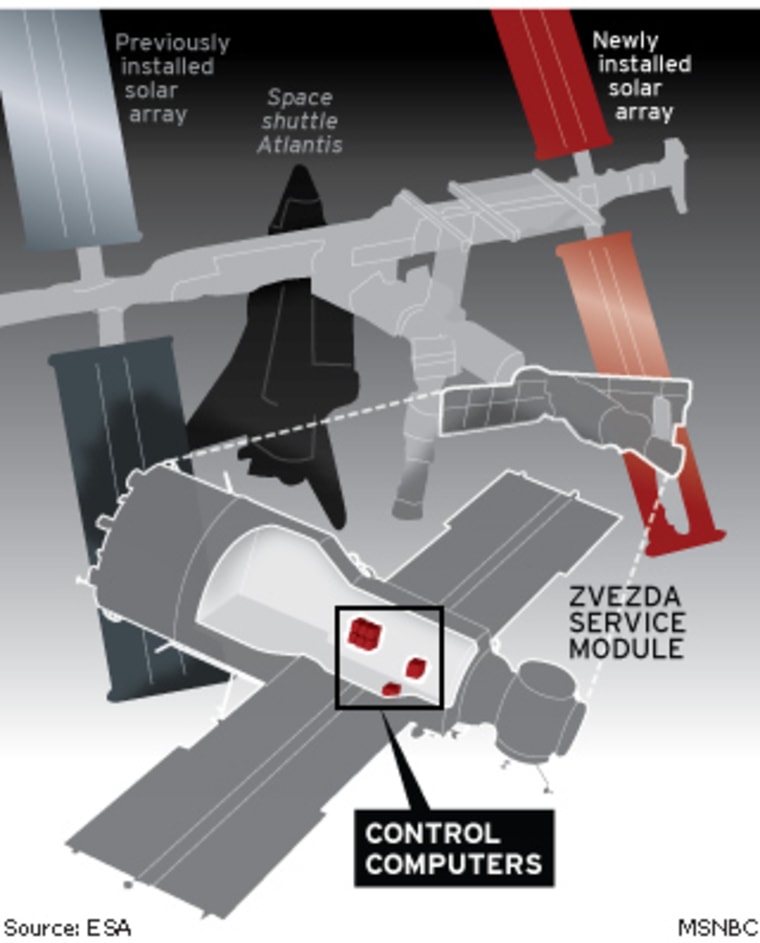Two Russian cosmonauts began to get crucial computers up and running Friday, four days after they crashed at the international space station and curbed the outpost's ability to orient itself and produce oxygen.
The progress came after days of frustrating effort and, for the time being, removed a set of troubling options lying ahead for NASA and the Russian space agency if the computers continued to fail. "We feel like the computers are stable and back to normal," said Mike Suffredini, space station program manager.
Meanwhile, U.S. spacewalkers resolved another concern by stapling down a bent-back corner of the shuttle Atlantis' thermal protection blanket — a gap that NASA feared would cause problems during the shuttle's atmospheric re-entry next week.
After a couple of all-night debugging sessions, space station cosmonauts Fyodor Yurchikhin and Oleg Kotov bypassed a power switch with a cable to get four of six processors on two computers running.
The computers began operating the cooling system in one of the space station's Russian modules. But Suffredini said engineers would look at how the computers performed overnight before deciding whether they can start running other space station systems Saturday.
Suffredini said he doesn't expect the two processors that currently aren't working to come back online. They will be replaced.
He said engineers are still trying to determine what prompted the power switch to cause the computers to fail.
Worst-case scenarios
Had the machines continued to malfunction, the three-member space station crew could still have remained on board, but other steps would have been taken to maintain oxygen supplies. Russia had already begun to move up plans for a cargo ship to deliver supplies, including new computers, next month.
And ominous questions were raised about the possibility of eventually needing to bail out of the space station — something Suffredini rejected earlier in the day.
Maintaining the correct position in orbit is key for the space station. It must point its solar arrays at the sun for power and be able to shift orientation to avoid occasional large debris that comes flying through space.
The computer crash came as Atlantis' astronauts were resuming work on the long-running construction of the station. The seven shuttle astronauts arrived last weekend, marking NASA's first visit to the space station this year.
During the computer failure, the shuttle's thrusters helped control the station's position. In addition, some of Atlantis' lights, computers and cameras were turned off to save energy in case in case the shuttle had to spend an extra day docked to the station to allow more time to figure out the problem.

NASA officials said the crew was never in danger of running out of oxygen, power or essentials.
However, the failed computers were the latest technical glitch for the half-built, $100 billion outpost. In past years, a Russian oxygen machine and gyroscopes, which also control orientation, have failed.
Critics have called the space station a boondoggle, an ill-conceived, post-Cold War venture between the superpowers which at the moment is producing little science as it undergoes construction.
The days-long computer problems fueled skepticism toward the Bush administration's "Vision for Space Exploration," which calls for finishing the space station in three years, grounding the space shuttles in 2010 and building next-generation vehicles to go to the moon and Mars.
"This growing chorus of opposition to the current vision ... is finding expression in the difficulties of the station," said Howard McCurdy, a space public policy expert at American University. "We're learning a great deal from the space station, and one of things we may be learning is we shouldn't have built this particular one."
Fixing the blanket
While the Russians worked to bring the computers back up, Atlantis' spacewalkers accomplished another mission: repairing the torn thermal blanket. The blanket is made of tough sheathing that helps protect the shuttle from heat on its return flight to Earth.
Danny Olivas used a medical stapler to successfully secure in place the 4-by-6-inch (10-by-15-centimeter) corner, and James Reilly installed an external valve.
"Hopefully it's going to be good, good enough," Olivas said after finishing the repair.
The 11-day mission was extended by two days so the rip in the thermal material could be fixed.
Before Friday's nearly eight-hour spacewalk ended, astronauts also finished folding up a 115-foot (35-meter) solar wing on the space station. It took several days to put away the wing, which needed to be retracted to allow for the free movement of the newly installed pair of power-generating wings.
For now, Atlantis is set to land at NASA's Kennedy Space Center in Florida on Thursday.
This report was supplemented by MSNBC.com.